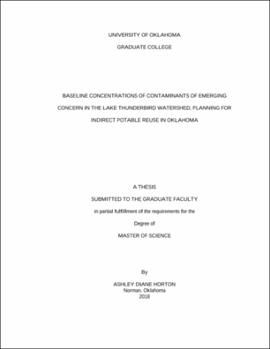| dc.description.abstract | The City of Norman, OK is planning an indirect potable reuse (IPR) project to augment their water supply. The IPR project involves transferring treated effluent from the Norman Water Reclamation Facility (NWRF) to Dave Blue Creek, which flows into Lake Thunderbird and acts as an environmental buffer. One of the major concerns for IPR projects is the presence of contaminants of emerging concern (CEC) in recycled wastewater. CEC are broadly defined as chemicals that can potentially enter the environment, but that are not routinely monitored and could pose health risks to humans or ecology. The objectives of this thesis research are to analyze baseline CEC concentrations in the lake, evaluate periodic tendencies, compare results to previous CEC studies, and identify probable sources for the detected CEC. Stakeholders can use the results to assess the effectiveness of the environmental buffering, and design necessary advanced water treatment at the NWRF before the IPR project commences.
Four water sampling events were completed at Lake Thunderbird in Norman, OK during 2016 and 2017 with each event representing a season. Water samples were collected at six lake sites and analyzed for 113 unique CEC including compounds in four categories: 1) industrials, 2) pesticides, 3) pharmaceuticals and personal care products (PPCP), and 4) “others”. Sub-watersheds were delineated and loading factor models were developed for each sub-watershed to assess potential CEC contributions based on land use, density of domestic wells (as a proxy for density of septic tanks), and density of storage tanks.
Eight, 21, 24, and 24 CEC were detected in June 2016, October 2016, January 2017, and April 2017 samples, respectively. The compound NP was detected in fall, winter, and spring, making it the most frequently detected industrial compound. The pesticides atrazine and simazine were detected in every season, most likely because of year-round lawn or agricultural applications. Acesulfame-K (artificial sweetener) and DEET (insect repellant) were also detected in every season, those compound detections could be the result of runoff from residential areas or from recreational use of the lake. CEC are likely derived from seasonally variable sources, such as lawn applications and septic systems. Concentrations of atrazine, simazine, and 2, 4-D detected in Lake Thunderbird are well below EPA established maximum contaminant levels (MCLs) for drinking water. Nine other compounds detected in Lake Thunderbird are below non-federal health standards, available from the Minnesota Department of Health, which indicates that Lake Thunderbird water is likely safe for consumption with regard to CEC.
Comparison of Lake Thunderbird CEC concentrations to a microcosm study of Norman Water Reclamation Facility (NWRF) effluent in Dave Blue Creek sediment with photosynthetically active radiation (PAR) indicate that the environmental buffering may sufficiently reduce concentrations of CEC before they reach Lake Thunderbird during the planned IPR project. Future investigations should define the half-life and health standards that are presently unavailable for the 113 CEC analyzed in this study. Additional investigation, sampling, and analysis of current NWRF effluent discharge and receiving waters of the Canadian River would be beneficial for documenting environmental buffering effects. | en_US |
